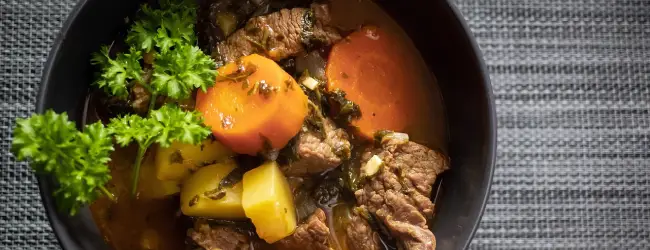Recently, I have often mentioned how to reduce food costs. And the “universal taste” cooking method is one of my new concepts for it. So I created a new tag (tag: universal taste). Please check it out if you want these old articles.
Today, I’ll talk about its example recipes. If we understand this method, we might be able to cook tasty dishes while reducing food costs.
Summary of “universal taste”
First, I summarize the “universal taste” cooking method. This is a method aimed at achieving both food cost reduction and satisfaction with our meals. It could be updated from the past because I’m developing it now.

In this method, we assume that we have 5 tastes, as follows:
- (↑Fast taste, feel excitement)
Bitterness and sourness: pepper, herbs, hot chilis, vinegar, etc. - Fat: Vegetable oils, Butter, meat fat, etc.
- Sweetness: Sugar, starch, etc.
- Saltiness: Salt.
- Umami: broth, stocks, juice of fermented foods, etc.
(↓ Slow taste, feel fulfillment)
We cook our meals while balancing these tastes. We can use affordable ingredients to fit these tastes based on our situations. And if we value slower taste, we can reduce condiments because we can feel fulfillment with simple taste. These ways will reduce food costs while satisfying our meals. This is the “universal taste” cooking method.
So, let’s introduce its examples. I will pick up two cases: tomatoes and beef soup.

The example of tomatoes
The first example is tomatoes. Tomatoes mainly have (1) sourness and (3) sweetness. So we can say that tomatoes are a fast-tasting kind of food. (By the way, almost all vegetables except root vegetables are fast-tasting kinds of food.)
So if we eat tomatoes with (4) salt, we can feel more fulfillment because it becomes slower taste.
And if we want to make a more balanced dish with tomatoes, we add more tastes. For example, we can add herbs and vinegar as (1) bitterness and sourness, such as basil and wine vinegar. Then we add olive oil as (2) fat. We can also add salt as (4) saltiness, and grated anchovies as (5) umami. Umami is one of the protein tastes.

Rationality of dishes
Perhaps you have seen such a dish in Italian cuisine. Tomatoes with herbs, vinegar, olive oil, and sometimes anchovies. (We can remove anchovies if we don’t need so slower taste.) This is one of the balanced combinations. With universal taste, we can understand the rationality of these dishes.
If you have cheese, you can also use just cheese. Cheese has (2) fat, (4) saltiness, and a little (5) umami. So if you eat tomatoes with cheese, you can enjoy similar fulfillment even with no herbs, oils, or anchovies. Cheese is one of the best complements to the taste of tomatoes. We can understand that this is also one of rationality.

So we can use affordable ingredients instead of costly ones. If herbs are expensive and we can get peppers affordably, we can use them instead of herbs. If we can use sesame oil affordably, we can use it instead of olive oil. They give us a reduction in food costs with similar fulfillment.
Then we reduce the ingredients or condiments of faster taste, such as peppers, herbs, vinegar, and oils. They cost a lot. And we value slower tastes. Although it will reduce excitement, it will give us more fulfillment while reducing costs.
The example of beef soup
The other example is beef soup. This is almost the same as tomatoes.
In European cuisine, they often use carrots, onions, and celery, called the “holy trinity,” in their soups. Many people believe that they must use them to make tasty soups.
But we don’t need to stick to them. We can use affordable substitutes. In this case, celery mainly makes (1) bitterness. Carrots make (3) sweetness. Onions make (5) umami if they are sautéed until browned. So they create a balanced taste. And if we can understand these roles of ingredients, we can find affordable substitutes with similar fulfillment.

For example, if we use flour for (3) sweetness, it will be a kind of beef stroganoff, a Russian food. If we use bell peppers for (3) sweetness, it will be a kind of Cajun or enchilada soup, a South American or Mexican food. If we add potatoes for (3) sweetness, and soy sauce and rice wine for (5) umami, it will be Nikujaga, a Japanese food. If we use pork, chili oil, and soy sauce, it will be a Sichuan dish. Fish sauce and coconut milk will make it Thai cuisine. Garlic, ginger, and garam masala would turn it into Indian food.
They will also provide us with similar fulfillment as the “holy trinity” in European soups.
In other words, we can make our cuisine with affordable ingredients. It gives us similar fulfillment. Then we reduce the ingredients or condiments of fast taste. It reduces our food costs.
And we can apply this not only for cooking but also for our lives. We can get affordable materials to create our lives.
Conclusion
So we can reduce food costs with satisfaction by using my “universal taste” cooking method. This is the way of thinking I use.
If we understand this method, we might be able to cook tasty dishes while reducing food costs.
Thank you for reading this article. I hope to see you at the next one.


